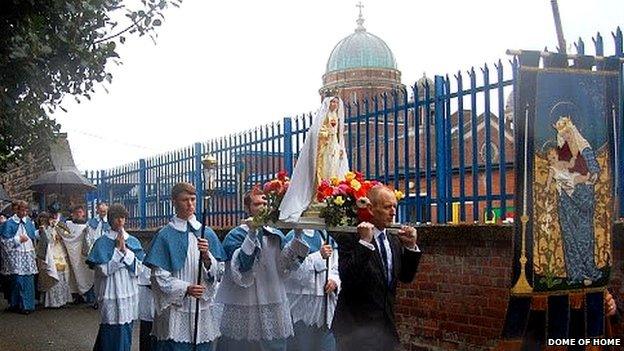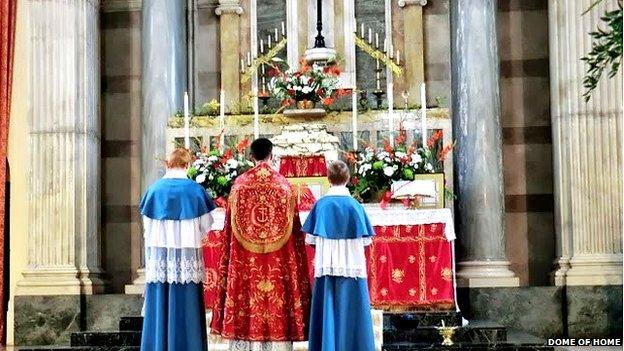New lease of life for 'Dome of Home' in New Brighton
- Published

All services at Saints Peter, Paul and Philomena are in Latin

The church was closed in 2008

Wartime sailors called the Wirral landmark the Dome of Home
Once the pews in Saints Peter, Paul and Philomena were as packed as the beach, but three generations later New Brighton had died as a resort and the number of practising Catholics had declined.
By 2008 it looked as if the church might follow the fate of the resort's former pier and tower when the Diocese of Shrewsbury announced its closure.
But the combination of a local campaign, Pope Benedict XVI's encouragement of the restoration of the Latin Mass in the Roman Catholic Church and a new bishop saw the church re-open.
In March 2012 Mass was celebrated by priests from The Institute of Christ the King - an international order based in Florence, Italy.
But the five years of neglect has taken its toll. The distinctive copper dome and its supporting brickwork need extensive renovation as the does the interior fabric of the building.
"People come inside and see this impressive dome and the Portuguese and Italian statues and decor but there is an awful lot of work that needs to be done," said Lee Jones, of the church's heritage committee.
Which is why the announcement of a £35,300 grant from the Heritage Lottery Fund (HLF) towards the restoration and renovation of the church is an answer not only to the church's prayers but also the local council.
'Latin devotees'
Devotees of Latin liturgy and local history are delighted, especially as a second phase of funding - which will need HLF approval - could see the church finally receive £169,200.
Rector Canon Amaury Montjean said it was wonderful news which would preserve the shrine as "beacon" for future generations.
Wirral Council's heritage officer Eileen Willshaw said along with New Brighton's regeneration it would "allow the rich heritage of this landmark to be more accessible to the local community".
Father Thomas Mullins raised funds to enable the Catholic population of the rapidly growing seaside resort to build a hill-top basilica, which opened in 1935, standing as a landmark at the entrance to the Port of Liverpool.
The result was a building originally intended to be the largest parish church in England.
"It coincided with plans for the Lutyens-designed Roman Catholic Cathedral in Liverpool which would have seen two large domes either side of the Mersey," said Mr Jones.
"The Lutyens cathedral was never built and this church was smaller than originally intended."
Sailors'comfort
During World War II, however, its distinctive pale green dome earned the nickname the Dome of Home, because sailors could see they were close to Liverpool as they returned from the Battle of The Atlantic.
When the former Bishop Brian Noble announced the closure it sparked a grass-roots campaign by parishioners and other local people to save the church.
They were backed by local Conservative Councillor Paul Hayes who said: "I was passionate that such an iconic building should not be left to become derelict, especially seen as though there was such huge support for the church to remain open, not just from parishioners but also the wider Wirral community."
He added: "The architectural and cultural heritage of Wirral has been dealt a huge boost with the HLF announcement as it means that the future of one our cultural gems is that little bit more secure."
Designated as a shrine by Bishop Mark Davies, the church is no longer has a parish but instead is a place where all of the devotions are celebrated in Latin, the traditional language of the Roman Catholic Church with Masses celebrated under the Tridentine Rite.
"We normally have around 150 people from a wide area for our Sunday Mass, " said Mr Jones. "On a special feast day we can get hundreds of people coming."
He said some of the lottery funding would also help train tour guides and pay for a guide book and upgrading of the website.
New Brighton has had four landmarks, the tower, the pier, Fort Perch Rock and the Dome of Home, according to Mr Jones.
The tower was dismantled in the 1920s and the pier in the 1970s.
"Now there's only ourselves and Fort Perch Rock left," he said.
- Published12 August 2013